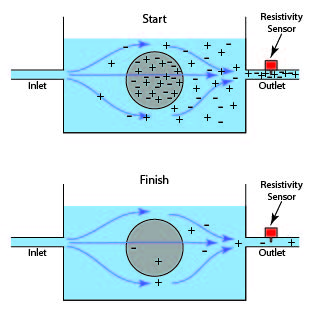Previous blogs have discussed the importance of rinsing as part of the overall cleaning process. Because of its importance, many schemes have been devised to assure that parts are adequately rinsed after cleaning. Most of these schemes embrace the “more is better” concept which often leads to overkill as there is often no practical way to verify the adequacy of rinsing. Although rinsing is important, it is also expensive! Multiple rinses and high flow rates can add considerably to the cost of cleaning as equipment and utility costs escalate. Although it is not perfect solution in every case, “rinse to resistivity” may offer a means to assure (and verify) adequate rinsing while controlling cost, especially in highly critical applications.

The concept of rinse to resistivity is quite simple as shown above. As I stated at the outset, however, it is not always viable in every cleaning application. In order for rinse to resistivity to work, certain criteria must be met or considered.
- The contaminant to be rinsed off must be conductive. If the contaminant is not conductive (and there are some that are not) the resistivity meter will not be able to see any resistivity related to the contaminant and give a misleading result. This is especially likely in the case of particles. The resistivity may be below the target level even though a significant number of particles are still present in the rinse.
- The rinse vessel volume should be as small as possible yet still accommodate the parts being rinsed. If too large a vessel is used, one of two things can happen. First, the contaminant on the part may not provide enough ions to register on the resistivity meter thereby indicating an adequate rinse when, indeed, little or no rinsing has taken place. Second, the turnover time of a large vessel may significantly delay the detection of an adequate rinse condition.
- Adequate flow rate must be supplied to provide a short turnover in the rinse vessel. If the flow only provides one tank turnover every 20 minutes (for example) it may take 20 minutes to see the resistivity as measured at the outlet to increase enough to show a complete rinse.
- The incoming rinse water must be significantly lower in resistivity than the target resistivity at the outlet. If it is not, it may take longer to achieve the target resistivity. Of course, if the resistivity of the incoming water is above the target resistivity level, complete rinsing will never be achieved.
Rinse to resistivity is a useful tool but must be applied correctly to be of benefit. In many applications, rinse to resistivity is simply not applicable. When considering rinse to resistivity, make sure that the quality people, the process people and the equipment manufacturer are on the same page. Otherwise, the results may be less than expected.
– FJF –



 English
English Spanish
Spanish Chinese
Chinese Canada
Canada Mexico
Mexico United Kingdom
United Kingdom




2 comments on “Rinse to Resistivity”
What do you feel is wrong with the illustration?
I think the illustration is corrupted.